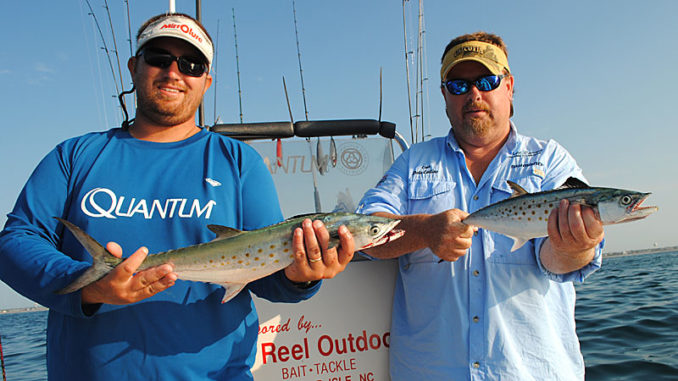
Spanish mackerel, Scomberomorus maculatus, are long, slender fish with deeply-forked tails and sharp teeth. Their bodies present greenish backs, silver sides and belly and numerous yellow spots on each side. They have distinct lateral lines that gently curve toward the tail of the fish, and they are covered in very tiny scales.
As Spanish mackerel mature, the yellow spots sometimes fade, especially in bigger fish. Because of this, big ones are often misidentified as small king mackerel, a larger cousin to the Spanish. This can cause big problems for anglers, since the two species have different size and creel limits in most states.
One of the easiest ways to distinguish the two subspecies is by paying close attention to the lateral line, which stands out visibly for both fish. This line on king mackerel has a very sudden drop, unlike those on Spanish, which drops more gradually, and more slightly.
Hearty eaters
Spanish mackerel spend much of their lives in open waters, and are spread out from New England to the Yucatan Peninsula. They migrate with water temperatures between those two extremes. They are voracious eaters and will eat pretty much anything small enough to fit in their mouths. Numerous species of smaller fish make up the bulk of their diet. They also eat their share of squid and shrimp.
Their travels often take them close to shore — even into the mouths of rivers throughout their range. They spawn in the open ocean from May to September and begin spawning at around 2 years of age.
World-class speed
Anglers catch Spanish mackerel from piers, boats and even from beaches in some areas. One of the most-popular lures is the Got-Cha plug. Shiny spoons are also very effective, as are colorful jigs retrieved very quickly. These fish are fast and will ignore slower lures to chase down faster ones. Anglers often catch large Spanish while trolling live baits for king mackerel.
These fish rarely grow bigger than 37 inches long or heavier than 12 pounds. Most never make it to 18 inches or 3 pounds. The Louisiana state record weighed 10.56 pounds and was caught by Mike LeBlanc in August 1972. The world record weighed 13 pounds. Robert Cranton caught this fish in North Carolina’s Ocracoke Inlet in November 1987.
The post “Species Spotlight: Spanish mackerel” first appeared on MS-Sportsman.com.


